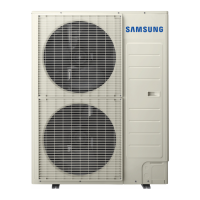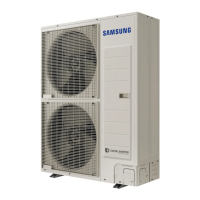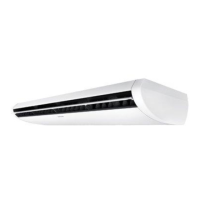Do you have a question about the Samsung AM036NXMDCR and is the answer not in the manual?
Details the structural components and features of the outdoor unit.
Highlights advanced features like BLDC fan, Turbo Inter-cooler, and Twin BLDC compressor.
Explains how wide fins improve heat transfer and delay frost formation.
Details the role of Liquid EEV and Turbo Inter-cooler in optimizing system efficiency.
Discusses enhanced corrosion resistance and capabilities for long piping and high level differences.
Explains the memory module for diagnostics and the silent operation mode for nighttime use.
Covers refrigerant recovery procedures and system data monitoring via View mode.
Details the ability to connect up to 9 indoor units and convenient installation features.
Provides comprehensive specifications for various models including performance, power, and dimensions.
Lists model-specific data, dimensions, weights, and operating temperature ranges.
Lists the essential tools needed for performing disassembly and reassembly procedures.
Step-by-step guide for disassembling various outer panels and internal components of the outdoor unit.
Detailed steps for removing fans, motors, electrical parts, and separating pipes.
Disassembly procedures tailored for specific models like the AM060NXMDCR.
Illustrates proper methods for refrigerant pipe installation, including serial and parallel configurations.
Highlights common mistakes and incorrect practices in refrigerant pipe installation.
Explains how error codes are displayed on the unit and their meaning.
A detailed catalog of error codes and their corresponding explanations and causes.
Provides diagnostic steps for communication errors between indoor and outdoor units.
Guides on resolving errors related to MCU branch part setup and address configuration.
Addresses issues related to sensor errors, open/short circuits, and connector problems.
Covers troubleshooting for compressor issues like antifreeze control, high/low pressure protection.
Addresses refrigerant leakage, phase errors, EEV issues, and IPM over current.
Guides on troubleshooting DC-Link voltage errors, input current issues, and EEPROM problems.
Diagram showing the layout and numbered components of the main outdoor unit PCB.
Detailed list of connectors, functions, and descriptions for the main PCB components.
Diagram and component list for the 1-phase inverter PCB of the outdoor unit.
Diagram and component identification for the EMI PCB used in the 1-phase outdoor unit.
Illustrates the complete wiring connections for 1-phase models, detailing component interconnections.
Schematic showing the refrigerant flow and key components for specific models.
Visualizes the refrigerant flow path during cooling operation for specific models.
Illustrates the refrigerant flow for main cooling operations in specified models.
Depicts the refrigerant flow during heating operations for specific models.
Shows the refrigerant flow for main heating operations in specified models.
Explains the coding system used for outdoor unit model numbers and their components.
Guide on initiating and conducting the automatic system check operation.
Lists specific components and parameters to inspect during the automatic check operation.
Steps to troubleshoot 'Undetermined' status related to indoor unit temperature sensors.
Procedure for diagnosing 'Undetermined' results for outdoor unit temperature sensors.
Steps for troubleshooting pressure sensor issues during automatic commissioning.
Guide to diagnose and resolve abnormal compressor operation during check operation.
Steps for troubleshooting and determining the cycle status of the outdoor unit.
Procedure to diagnose and resolve issues with the 4Way valve during operation checks.
Steps to diagnose and resolve problems with the Main EEV during automatic commissioning.
Explains the process and interpretation of automatic refrigerant amount detection.
| Voltage | 208/230V |
|---|---|
| Refrigerant | R410A |
| Energy Efficiency Ratio (EER) | 12.5 |
| Cooling Capacity | 36000 BTU/h |
| Heating Capacity | 36, 000 BTU/h |
| SEER | 16 |
| HSPF | 9.0 |
| Power Supply | 208-230V/60Hz/1Ph |












